|
|
 |
|
|
|
|
 |
|
|
DETAILED OUTLINE©
SECTION on mobile and wireless
e-
"m-commerce"
|
|
|
|
|
|
|
"... we are on
the threshold of a wireless revolution that will bring about the increasing
convergence of
handheld devices and cellular phones, fundamentally altering the landscape"
PricewaterhouseCoopers"The biggest risk for organisations is believing that m-business opportunities are two to three years away. The pace with which businesses accept emerging technologies is accelerating. M-business is here today, and growing at a tremendous rate. "
| Handheld
devices and their role in the development of m-commerce |
|
The results are
below. The teams had two different approaches to this task. Both results
are useful to look at as a summary of wireless business and m-commerce.
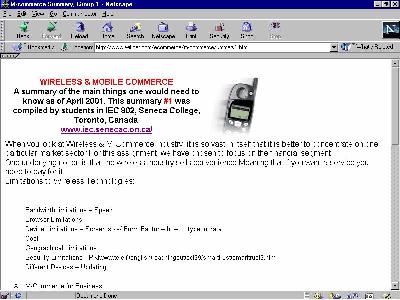 |
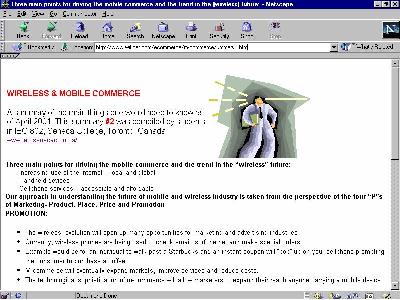 |
| . | Many of the professional service firms,
such as the accounting firms, law firms and management consulting companies
have addressed m-commerce in the PR material on their websites. PricewaterhouseCoopers
has a particularly good note on m-commerce since it addresses the all encompassing
aspects of its ffect on all business categories.
WTGR "The convergence of wireless devices and the Internet is creating an important new channel to market — and the next wave of change across industries. Mobile business, or m-business as it has come to be known, will enable organisations in every industry to
from www.pwcglobal.com/extweb/mcs.nsf/docid/CD62BE635F4F749C852569DD0054B892 |
| Physical Limitations
of mobile devices, which need to be addressed before m-commerce can fully develop |
"Wireless devices
demand new models of information delivery and knowledge management,"
says Dr. Mark Chignell, CTO of Personification Inc. and head of the Interactive
Media Lab at the University of Toronto.
To allow more data to be viewed on the cellphone screen, Personification has developed 2 new technologies, namely TextSummary and PhoneSummary
|
| Physical Limitations
of mobile devices, which need to be addressed before m-commerce can fully develop |
Friedman notes that "the mobile market is growing quickly. Almost 30 per cent of Canadian households have at least one mobile phone. Sales of Internet-equipped phones are skyrocketing, while sales of PDAs are expected to double over last year's. There will soon be a vast, mobile Internet-equipped market hungry for content and services." however, despite this trend, Friedman cautions
"...You can't build much of a display into a mobile phone without seriously
compromising its portability, and unlike computers, most mobile devices
are designed to be operated with one hand.... The killer app for the wireless
Internet may not be traditional Web browsing at
|
| "... the shift to wireless" | April 2000
Macaluso quoted IDC's prediction that by
mid-2001 all digital cellular devices will be WAP-capable. IDC
was further quoted by Macaluso as saying that the shift to wireless is
driven in part by a growing trend on the part of phone service and other
providers to encourage customers to use the Web for customer service, bill
paying and account information. It is a logical extension for these companies
to prompt consumers to buy products and services over their Internet-ready
phones.
"the mobile market is growing quickly.
Almost 30 per cent of Canadian households have at least one mobile phone.[Nov
2000] Sales of Internet-equipped phones are skyrocketing, while sales of
PDAs are expected to double over last year's. There will soon be
a vast, mobile Internet-equipped market hungry for content and services."
|
| bandwidth
and handset design limitations WAP |
November 2000
"The mobile Internet market is growing quickly, but bandwidth and handset design limitations mean the wireless experience won't match the desktop experience any time soon."
"WAP has been hyped as the be-all and end-all
of the wireless Internet, but it's important to remember that it's just
one of many technologies,"
"... WAP has to overcome at least two substantial obstacles before it's really ready for prime time. The first problem is that for now, digital wireless connections are limited to a glacial 9600 bits per second — about a sixth the speed of a pokey 56k modem. It's unlikely that anyone would have much of an "Internet experience" at that pace. However, the bandwidth issues are sure to be solved in due course. A more serious question is whether
handheld, mobile wireless devices like cell phones and personal digital
assistants are even particularly well suited to online browsing. You
can't build much of a display into a mobile phone without seriously compromising
its portability, and unlike computers, most mobile devices are designed
to be operated with one hand."
|
| Q. Who are some
of the early players in the wireless web access developments? A - Phone companies
|
CNET had a story in December 1999 about
Bell Atlantic's offering of wireless
http://news.cnet.com/news/0-1004-200-1431602.html?tag=st.ne.ni.rnbot.rn.ni  |
| . | Everybody seems to have some say on the
situation of wireless business and mobile e-commerce (m-commerce for short).
Most of the time we see articles and opinons on m-commerce in leading newspapers
and e-zines but there are also trade publications and industry association
reports that discuss this impending tidal wave.
Or, is it just hype. Is it a case of technology seeking a purpose? By March 2001 we have seen enough talk about m-commerce to presently be aware of journalists and e-experts discussing how the wireless world, in terms of actual business activity, is taking off more slowly than anticipated? Why is this the case? Is there a problem finding the killer ap among business to lead wireless commerce around the world? Possibly. People always say that if you forget history you are doomed to repeat it - in this case, it would do us well to look at how some killer aps boosted older technologies - and by looking at those older situations, see if we can find some twinkle or sign that will allow us to know what will be the killer ap that will cause wireless services to take off. WTGR |
| Older
technologies |
What were record players used for in the beginning, and why were they invented? The pioneers of the record player were Thomas Edison, (1847–1878) with his phonograph, and Emile Berliner (1851–1929), who invented the predecessor of the vinyl record 1896. Edison's records were made of tinfoil, upon which a groove of unvarying lateral direction but varying depth was cut. Edison claims to have had as one of his original purposes, being the relationship between a businessman dictating letters to a secretary. Edison tried to produce a machine that would record the gentleman's speech, which could then be later played back by the secretary in a manner which would allow her to type out the words. What we fail to see sometimes is how quickly older inventions also spread fast and had their diverted and entertaining applications. How many readers of this page would be surprised to learn that edible records made of chocolate were a culinary delight in 1903. Of course, in 2001, we know that the phonograph's Killer Ap was not business oriented, but rather applied to music and it was entertainment purposes that drove subsequent developments. The reason we deliberate on this historical tale in IEC 802/812 is to keep in mind that all the businesses presently trying to find a great Ap for wireless technology, may be missing (what has been historically a great driver of inventions) the most powerful Ap - entertainment. written with notes
from Prof. Richardson's class on History of Technology
|
| . | Wireless e-business will not develop strongly
unless there is a "killer ap". A really good application of any
technological development has always been necessary in order for something
to become very popular.
Therefore we will look at some of the developments
in wireless banking to see if there is, or is not, a potential there.
|
|
WIRELESS BANKING WIRELESS
WIRELESS
|
Historically speaking , the ease with which "first adopters" use a new technology, and its application, is critical to whether it will contine. When pocket pagers first came out they were bulky, expensive and had limited coverage - it wasn't until the cell phone industry took off in the mid-1990's that pagers had a system to piggyback on (the cell phone network) to carry their signal - then they became popular. Solomon cautions that "Wireless won't be a big money-maker for the financial services industry, but banks and brokerages are slowly adding it to their product offerings" because no one wants to be left behind. If there room for optimism. Solomon notes
" industry analysts say there's no one wireless killer app, getting
access to financial services is thought to be one of the biggest reasons
why people will want Internet-enabled cellphones and personal digital devices,
which are slowly entering the market."
The situation in March 2001
In conclusion, Solomon offers that "the
future of wireless financial services is in the hands of carriers and device
manufacturers. With bigger screens, users can get graphs and more
than three lines of information. But the networks that can handle
such data are at least a year away."
|
|
WIRELESS BANKING WIRELESS
WIRELESS
|
Mark Dickelman, vice-president of m-commerce and wireless for the Bank of Montreal, as quoted by Berry, says he "fully expects wireless banking to surpass the popularity of PC banking in record time." The full story, at
BOM implemented the Sun infrastructure
and hardware and 724’s E10,000 solution in anticipation of customer
demands. Dickelman noted "the wireless market may not have boomed yet,
but when it does the bank will have a well-run solution. Veev.com
allows the bank’s wireless clients to access all account transactions,
re-order cheques, take part in the bank’s brokerage services and do some
trading," according to Dickelman.
|
|
What does wireless mean to the human experience? What does
|
What is instant information? (WTGR)
|
| the human business
relationship experience: location determinant
the human business
location determinant
the human business
location determinant
the human business
location determinant
|
16th century Germany - the village blacksmith locates his forge next to the inn, which has stables for horses (which needs his horseshoes) and cooks that need his metal utensils - he is across the street from the local church which draws a large group of travellers from the outlying farms twice a week. 20th century Scarborough - the Macdonald's franchise owner buys real estate across from the local high school, which is adjacent to a medium size mall which is only served presently by a Becker's and a Tim Horton's. Both of these situations are location determinant - meaning the factors of
21st century downtown Toronto - February 2000 - a renovated building in the fashion district, now housing dot.coms. A website with small sized consumer products for sale. Content is multilingual and payments systems are varied. Shipping is cost effective.
21st century northern Mississauga - October 2002 - a renovated warehouse formerly belonging to Nortel Networks. A m-commerce service center uses advanced Bluetooth technology to target cell phone carrying pedestrians in the downtown Toronto core. The client, Tim Horton's which has been specializing in small size franchise locations.
|
| The
Technology 2.5G
|
As Andy
Walker notes
"The wireless phone industry is moving toward a next-generation wireless technology known as 3G, which will allow wireless data connection speeds of up to 2 megabits per second (mbps) by the end of 2002 ... In the mid-term, a technology called 2.5G will be rolled out which will enable speeds of 144 kbps" |
| Wireless
Future technology Java !
Wireless
Java !
Wireless
Java !
|
From Lazaridis speech, as quoted in The Globe and Mail, Mr. Lazaridis said, "... the much-touted third-generation (3G) of wireless devices is closer than we think. Technology called 2.5G already delivers everything we want — including e-mail, short messaging services, voice communication and location management — with the exception of full-motion video. These services — e-mail, voice, SMS and paging — are already available, and most people just need to be made aware of their presence, he said. "The key is people start using [the technology] and don't even notice it," he said. "It's the ultimate passive experience." RIM is also betting that a new version of Java for mobile devices, called Java 2 micro edition (J2ME), will be what powers all wireless devices of the future, he said. " Lazaridis added "We must move to one universal,
powerful, open standard,... benefits of J2ME are the reduced cost of setting
it up, the wide capabilities of the programming language, the ability
to store data locally, its security features and its ability to be upgraded
from a remote position."
|
| . | What is Bluetooth
Bluetooth enabled devices, such as handhelds,
will allow wider range access to the internet but at present (August 2000)
no such devices are publically available. The reason for mentioning this
now is that future applications will greatly increase the number of people
accessing the internet from various mobile devices. Even more people accessing
the Internet means more potential customers for B2C situations.
"The idea behind Bluetooth is to avoid
the inconvenience of cables by enabling devices such as mobile phones,
PCs, printers and handheld computers to communicate with one another over
short distances using low-power radio signals to transmit data"
|
||
| The
Technology "Bluetooth" |
www.bluetooth.com
An industry consortium developing technology specifications for small form factor, low-cost, short range radio links between mobile PCs, mobile phones and other portable devices. "The Bluetooth communications device is a small, low-powered radio in a chip that will "talk" to other Bluetooth-enabled products, eliminating the need for cables or infrared beams to connect portable computers, cellular phones, printers, fax machines, etc. It will be possible to connect enabled devices on a one-to-one or one-to-many basis. Since the chip supports both voice and
data communications, applications will range from something as simple as
replacing the cable between a mobile computer and cellular phone, to more
complex connections involving multiple computers, and extending into
hands-free voice communications for wireless phones in vehicles."
ZDNET's list of online articles about Bluetooth
|
| Industry
Associations 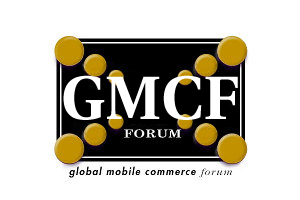
global.mobilecommerce.com Global Mobile Comerce Forum |
In their own words "The Global
Mobile Commerce Forum is a diverse group of companies from around
the world, companies that want to have a say in the future of mobile
commerce, working together towards a future where consumers will be able
to use their mobile phones (or other devices) to carry out their
business wherever they are, whenever they want."
Industry association web pages (including
press relases and statements of intent) are helpful sources of information
about an industry sector as a whole.
GMCF comments that "Judging by the development
of the Japanese and European mobile industries, it
will be the entertainment and leisure
"Another key to the widespread uptake of
mobile commerce will be the rapid creation of portals, providing specialised,
personalised content...The mobile operators should be encouraging the growth
in the number of portals, preserving their interest through joint ventures,
cross-marketing agreements and shareholdings. For the mobile commerce
industry
|
| m-commerce
but ... m-commerce
|
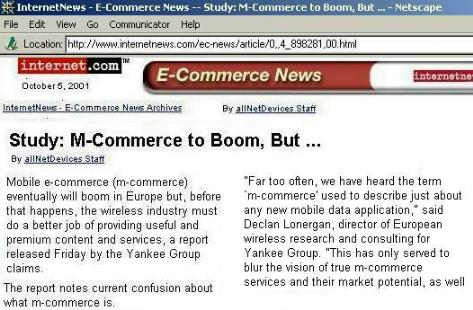
The article discusses how many people consider m-commerce in an un-focused way without breaking it down into subsets. The article suggests "m-commerce should be divided into three types, ...
This article was based on a 2001 report
titled
|
| m-commerce
around the world  |
"UK Wireless Usage Poised
for 'Hypergrowth'
By Nora Macaluso, E-Commerce Times June 8, 2000 
www.ecommercetimes.com/news/articles2000/000608-7.shtml Macaluso writes "All new mobile phones
sold in the UK will be Internet-enabled by mid-2001, according to
a report from Forrester Research.
|
| m-commerce
in China m-commerce
|
"Wireless B2B E-Commerce Developing
in China"
By Jim Romeo, E-Commerce Times, January 21, 2000 
Romeo's story is based on a report by the
Yankee Group.
Who is "getting in on this action"?, the
Yankee Group notes that " MeetChina.com, China's official cross-border
Internet trade portal, recently signed an agreement with Motorola, Inc.
and China Wireless Information Network to broadcast B2B purchase inquiries
to a potential audience of over two million people using Motorola wireless
communication devices in China."
|
| m-commerce
in China m-commerce
m-commerce
m-commerce
|
"Will China Look West for Wireless?"
"almost all of the country's subscribers use the global system for mobile communications (GSM) format promoted by European countries. " China Unicom however has expressed interest in Qualcomm's current code division multiple access (CDMA) technology "Qualcomm ... found that it wasn't exactly a welcome guest in China. After launching a trial of its code division multiple access (CDMA) cell-phone technology in cities like Shanghai and Beijing, last June Qualcomm found itself out on its ear when China's number-two state telecom carrier, China Unicom, decided to scrap deployment plans. Then, in October [2000], the China Unicom reversed itself and announced that it will build networks using Qualcomm's CDMA" Size of the market "China's 1.3 billion population has long
been irresistible to Western companies. While analysts
Payment Systems "Those markets have 80 to 90 percent prepaid subscribers, which shows the effect prepaid services can have in an economy in which people don't have a lot of disposable income. This is important since China is a cash economy. It allows operators to tap into a huge market of people they weren't getting before." "Billing systems are very weak in China,... You can only get an itemized bill for something after you pay for it" says Harr Brickson Technology "Of course, with an expanding market, China will have to move ahead with next generation technology. Third generation, or 3G, technology accommodates more users than the current GSM standard. It also offers users greater access to the kind of bandwidth-intensive applications Chinese new adopters are looking for, like wireless access protocol (WAP). Indeed, even as China remains undecided about which technology format to adopt, the country is already rolling out WAP. Even taking into account the often-stated problems with WAP, such as limited screen size and slow download speeds, AsiaInfo's Chief Strategy Officer Michael Zhao notes that, "The idea of using WAP is very popular right now. In big cities, you see billboards advertising WAP-based cell phones everywhere." Chinese Players "basically two players, China Mobile Communications Corp., with the largest geographic coverage and more than 90 percent of subscribers, and China Unicom. To spur competition, China's Ministry of Information Industry has allowed Unicom some pricing flexibility." Foreign Players Qualcomm - building networks for China
Unicom
|
| m-commerce
in Japan |

http://www.japaninc.net/mag/comp/2000/11/nov00_wireless.html A long, but very thorough article on mobile developments in Japan. This article covers all the latest [Nov 2000] developments being considered. points from the article by Daniel Scuka
|
|
|
When Prof. Richardson taught this course in 1999, one of the biggest topics was Y2K. Since that time in 2000 and early 2001, the general public seems to think we have passed any major crisis and it will be growth as usual - actually, that is not entirely true, there are still some more major problems to be solved, which, could threaten the future existence of the Internet and the World Wide Web. |
| Internet
needs space to grow Internet
Internet
|
"Ubiquitous Internet needs space to
grow"
Mr. Hamilton writes a long article about
the consequences of running out of IP addresses as more and more devices
and facilities are connected to the internet. He begins the article by
explaining the wide range of appliances and technologies that could be
connected tot he Net, which would require IP addresses in order to be "contacted"
and given commands.
"It's 2020 and, like electricity and running water, the Internet has come to power, and flows through every aspect of your life. Your personal computer and mobile phone aren't the only devices connected to the World Wide Web. Your microwave now surfs for recipes based on the ingredients in your cupboards. Your grocery orders are automatically placed online as food and drinks are taken from your fridge. Your dishwasher, before turning itself on, negotiates the cheapest energy rate for the day, thanks to a software agent known as a hydrobroker. Minivans. Air conditioners. Picture frames. Digital books. MP3 players. Palm computers. BlackBerry pagers. Smart cards. Pop machines. Motor boats.... They will all have a 24-hour, always-on connection to the Internet one day and, like the devices I mentioned above, they will all require Internet Protocol or IP addresses to identify them as unique online ``beings.'' Many experts suggest that the average person will need more than 100 IP addresses for his or her own use within the next 20 years. Herein lies the problem. The Internet, as it exists today, can't support 600 billion IP addresses. If we're lucky, it's capable of assigning 4.3 billion addresses. And if that's the case, we've already used up more than 60 per cent of the capacity, meaning we'll likely run out within the next few years. Can anybody say crisis? If you thought the Y2K bug threat was a major headache, then get ready for a migraine." |
| Internet
needs space to grow |
Latif Ladid, president of the
IPv6 Forum, has a powerpoint presentation on the IPv6 website which you
are encouraged to have a look at the first few slides.
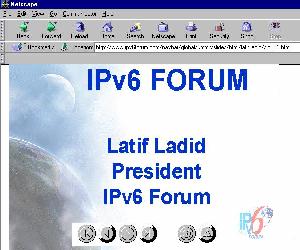 |
| Internet
needs space to grow Internet
|
http://www.zdnet.com/intweek/stories/news/0,4164,2349342,00.html McGarvey explains, "The major shortcoming of the current version of IP, IPv4, is that it is running out of available IP addresses. Designed when the Internet was still a data-sharing network for research facilities and the military, IPv4 was given a 32-bit addressing scheme, which was capable of assigning a few billion unique addresses. IPv6, on the other hand, is beefed up with a 128-bit addressing scheme, which enables it to spawn many more billions of additional addresses." McGarvey notes the first meeting of the
IPv6 Forum, an international advocacy group dedicated to advancing the
next generation of the Internet Protocol (IP), was held in Paris in October
1999.
|